Traditionally, life release is practiced by buying animals that would otherwise be killed, such as fish from a live seafood restaurant or a cow from the slaughterhouse, and setting them free, usually on special occasions such as a birthday or during serious illness. With growing affluence in recent times, however, instead of being an occasional event, at many Buddhist temples life release has become a regular activity, not only to (theoretically) create good karma for devotees but as a way to collect money from members. Moreover, the practice has been transformed into a highly choreographed ceremony involving thousands of animals each time.
FEATURES|THEMES|General
Rethinking Life Release
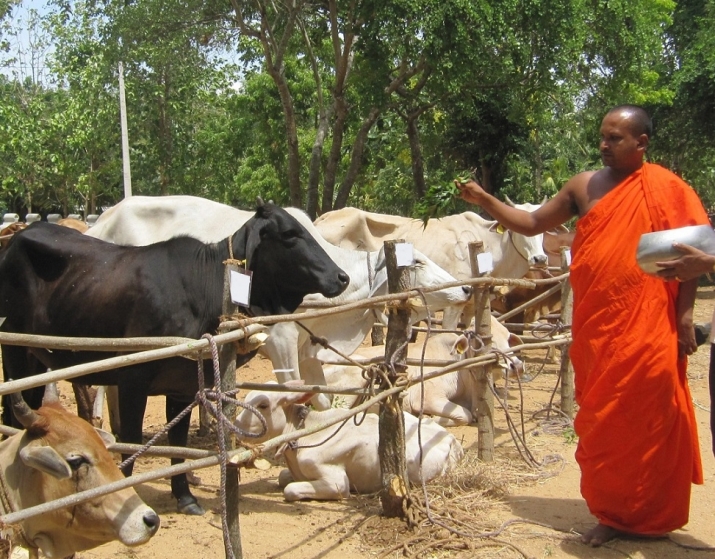 Blessing the animals saved in a release ceremony in Sri Lanka. From Shuyin
Blessing the animals saved in a release ceremony in Sri Lanka. From ShuyinIn recent years, the Buddhist practice of life release, or in Chinese, fangsheng (放生), has become a highly contentious topic, pitting life release advocates against environmentalists, animal rights activists, and even other Buddhists. While everyone agrees on the virtues of this ancient Buddhist tradition, it is the way in which the practice is being conducted by organized Chinese Buddhist groups, especially in China and Taiwan, that has raised eyebrows on many fronts.
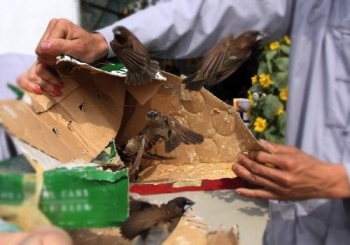 Freeing birds. From vietnambreakingnews.com
Freeing birds. From vietnambreakingnews.comThe figures are staggering. In Taiwan alone, the Environment and Animal Society of Taiwan estimated that more than 200 million animals ranging from insects to monkeys worth more than US$6 million altogether are released annually. (hsi.org) And a report in the China Economic Review published in November 2014 revealed that “the Beijing Fangsheng Association has released 15 million animals [in 2014] at a cost of over RMB6.9 million [US$1.1 million] to date. The group’s biggest one-day release ran up a tab of RMB441,352 [US$71,810].” (chinaeconomicreview.com)
How is it possible to procure so many animals for a single release? In these cases, rather than the animals freed having been in immediate danger of being killed, orders must be placed with suppliers well in advance to ensure delivery, by hook or by crook. Behind all the veneration of life release is a profitable animal trade that includes poachers, breeders, sellers, and many more, legal and illegal, supported and even sanctioned by Buddhist organizations that choose not to see it as a contradiction to the path of right livelihood! Even in Buddhist Sri Lanka, the introduction of mass releases of more than 100 cows on a regular basis has become a lucrative business for cattle traders and suppliers. Traditionally conceived as abhayadana (the giving of fearlessness or the giving of life), cattle release is now a festive spectacle, exploited for profit and political influence. From the old man peddling turtles in a Beijing market to the Singapore Kelong owner with a website promising minimally stressed fish and packaged services for liberation, life release has become a multimillion-dollar industry abusing animals of all kinds, farmed, reared, poached, captured, imported, or smuggled.
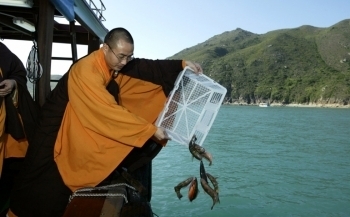 Releasing fish in Hong Kong. From scmp.com
Releasing fish in Hong Kong. From scmp.comSome may criticize this as religious profiteering that preys on the “kindness” of well-meaning Buddhists. But the business thrives because, as with all consumer goods, demand drives supply. The orders are unstinting, especially on auspicious occasions in the Buddhist calendar such as Vesak, the bodhisattva Guanyin’s “birthday,” and Full Moon and New Moon days. Encouraged by monks who tout life release as the highest meritorious deed and sing the praises of its numerous benefits, among them longevity, good health, success, and of course a good rebirth, many Buddhists believe that the merits accumulated are multiplied many times over on auspicious days.
Amid all the rejoicing, few are aware that their meritorious deeds are the cause of much suffering to the animals through the process of capture and confinement, and even after release. Animals that are captured in the wild can sustain extensive injuries from nets and traps. In transit, they suffocate or starve in tightly packed crates—sometimes for weeks—while awaiting release. And upon release, many suffer a slow and painful death from exhaustion, illness, or injury, or become easy targets for predators. For example, a study that used radio-telemetry to determine the survival of bulbuls and sparrows purchased from “merit sellers” in Hong Kong found that 6 out of 12 birds died within 3 hours to 10 days of release (hub.hku.hk). Further, animals that are bred to be sold for “life release” become traumatized when released in the wild, unable to cope with their new surroundings. Of the millions of animals released each year only a fraction survive, and some are even recaptured to be sold and released once again.
Mass life releases also wreak havoc on the ecology in many areas, prompting the US-based Society for Conservation Biology to issue a statement to religious institutions in 2013: “The manner in which ‘animal release’ is currently practiced raises concerns for biodiversity and ecological integrity that negate the ritual’s actual aim of compassion. ‘Animal release’ causes several adverse effects on biodiversity including the spread of invasive species, genetic swamping, extreme animal suffering, competition, vulnerability to predation, disease, and human health concerns . . . [T]he religious practice of ‘animal release’ poses risk to the future of biodiversity in Asia and other parts of the world where currently practiced.” (conbio.org)
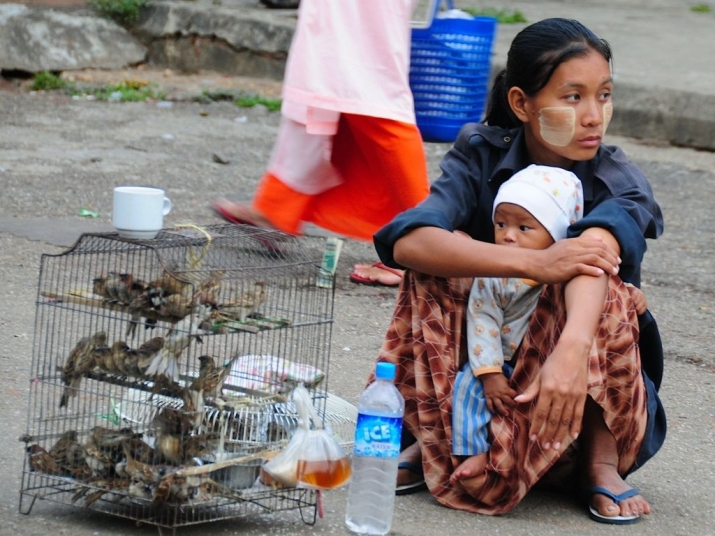 Selling birds outside Shwedagon Pagoda, Myanmar. From freebeautifulpictures.com
Selling birds outside Shwedagon Pagoda, Myanmar. From freebeautifulpictures.comHowever, in recent years, with increased publicity some ecologically conscious Buddhist organizations are collaborating with conservationists and animal rescue centers to set up alternative models of animal protection and release which will benefit the entire ecosystem. For example, in Taiwan, the Bliss & Wisdom Buddhist Foundation provides funds to the Endemic Species Research Institute, which treats wounded animals and releases them back to the wild, so that more lives can be saved. When the institute frees the animals, members of the foundation also participate and bless them. At the same time, eco-education provides members with better knowledge about conservation and appropriate freeing/releasing. (Liao 2013)
In Singapore, Buddhist groups are working with government authorities in “Operation No-Release” to raise public awareness about the detrimental effects of animal release on nature areas and waterways. (nparks.gov.sg) Individual temples, too, have taken the initiative to discourage devotees from blindly following tradition. For some years now, prior to Vesak Day, Singapore’s Buddhist Lodge has placed advertisements in the Chinese media urging Buddhists to protect (护生) rather than release life by being vegetarian for a day. (sbl.org.sg) Similarly, the US-based Humane Society International (HSI) and the American Buddhist Confederation “encourage the Buddhist community to support animal welfare instead of the ritual of releasing animals.” HSI has also drawn up a “25-action” plan on how to help and protect animals on its website. (hsi.org)
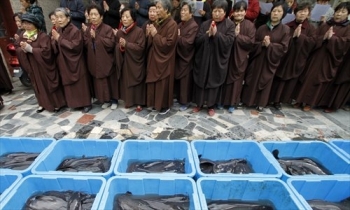 Fish prior to release, China. From globaltimes.cn
Fish prior to release, China. From globaltimes.cnAside from organizational rethinking, there is an ethical obligation for every individual to reflect upon his/her actions and motives for practicing life release. For whose welfare, actually, is the practice being performed?
Life release enthusiasts should look beyond their self-indulgence in “merit-making” to the untold misery and suffering being inflicted on the many animals they are supposed to be saving. We can help animals by making simple lifestyle changes such as reducing meat consumption or being vegetarian on certain days each month, avoiding products tested on animals, or supporting animal protection groups. We can certainly take a leaf out of the book of retired schoolteacher Yang Xiaoyun, who traveled 1,652 miles with 7,000 yuan (US$100) to save 100 dogs from being butchered at the Yulin Dog Festival in June. There was no elaborate ceremony, no loud chanting, no merit to be gained, and no profits to be made.
See more
HSI and The American Buddhist Confederation Discourage Harmful Animal Release Rituals (hsi.org)
25 Actions to Help Animals and HSI (hsi.org)
The booming business of the Buddhist "life release" ceremony (chinaeconomicreview.com)
Religious Release of Birds in Hong Kong (hub.hku.hk)
Religion and Conservation Research Collaborative (RCRC) Draft Position on the Religious Practice of Releasing Captive Wildlife for Merit for Consideration By the Religion and Conservation Biology Working Group (RCBWG) Board Society for Conservation Biology (SCB) (conbio.org)
Do not release animals into the wild (nparks.gov.sg)
李木源林长的护生观 (sbl.org.sg)
References
Gilbert, Martin. September 2012. “Characterizing the trade of wild birds for merit release in Phnom Penh, Cambodia and associated risks to health and ecology.” Biological Conservation. 153: 10–16.
Liao Ching-hui, Amanda. January 2013. “Set Them Free – Buddhist Organizations Set Up Models of Releasing Animals.” International Conservation Newsletter. Taiwan: Council of Agriculture Executive Yuan Forestry Bureau.
Liu Xuan, Monica E. McGarrity, and Yiming Li. 2012. “The Influence of Traditional Buddhist Wildlife Release on Biological Invasions.” Conservation Letters. 5 (2): 107–14.
Shiu, Henry, and Leah Stokes. 2008. “Buddhist Animal Release Practices: Historic, Environmental, Public Health and Economic Concerns.” Contemporary Buddhism. 9 (2): 181–96.














